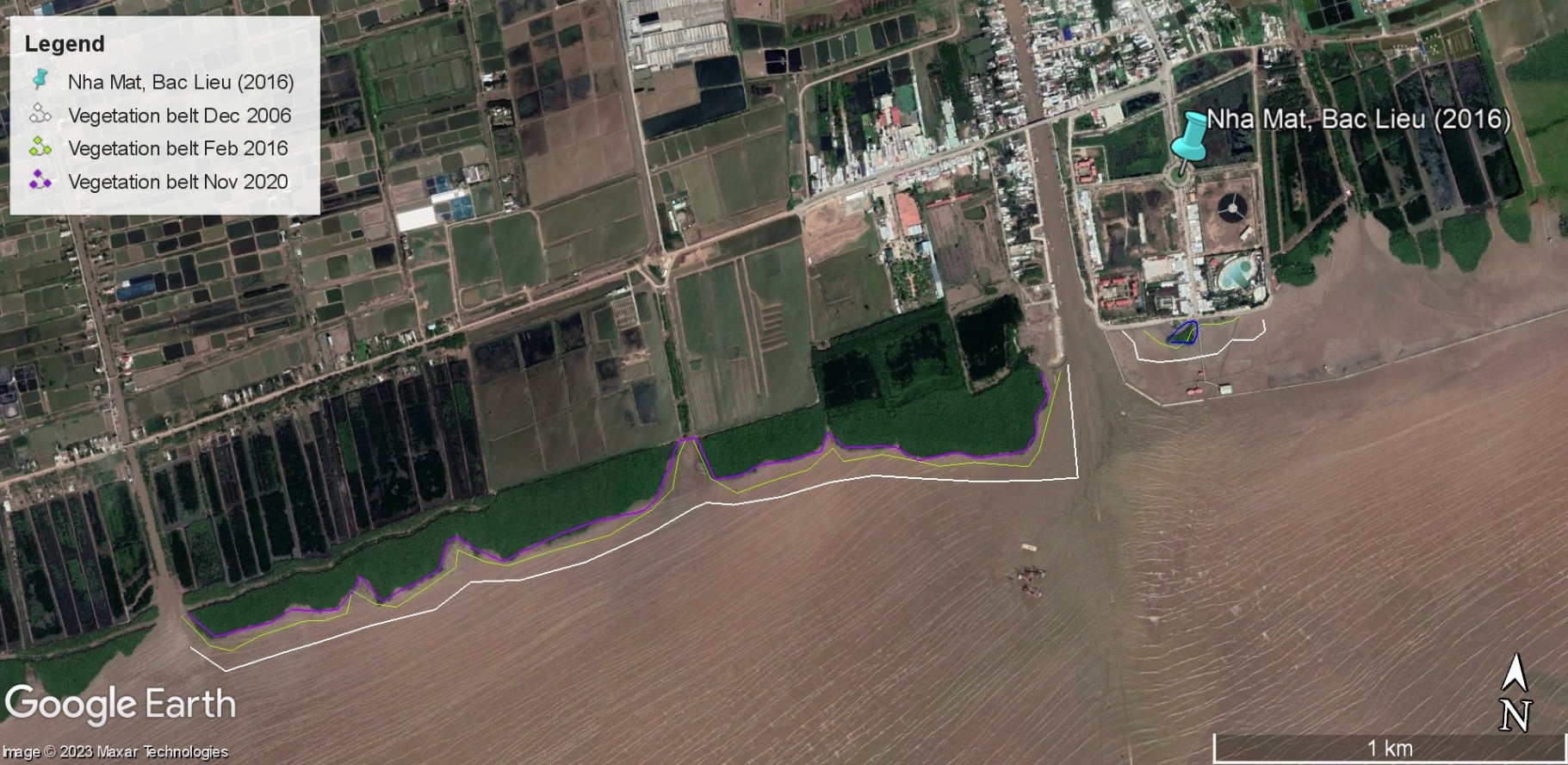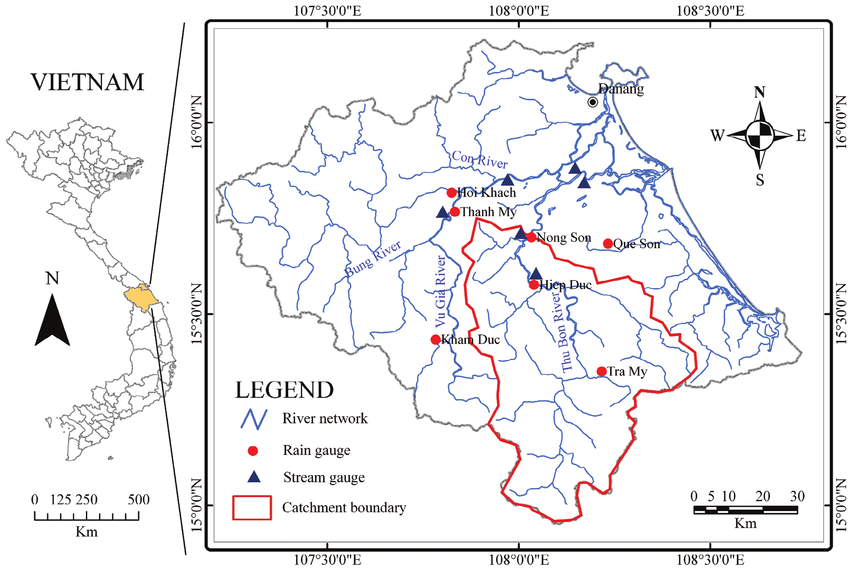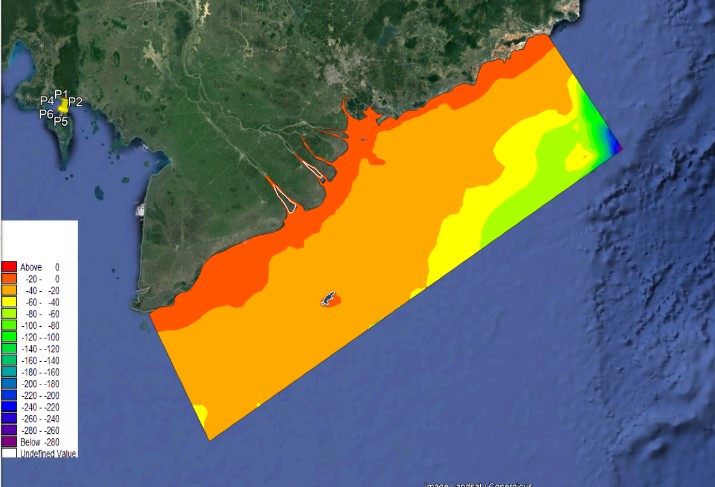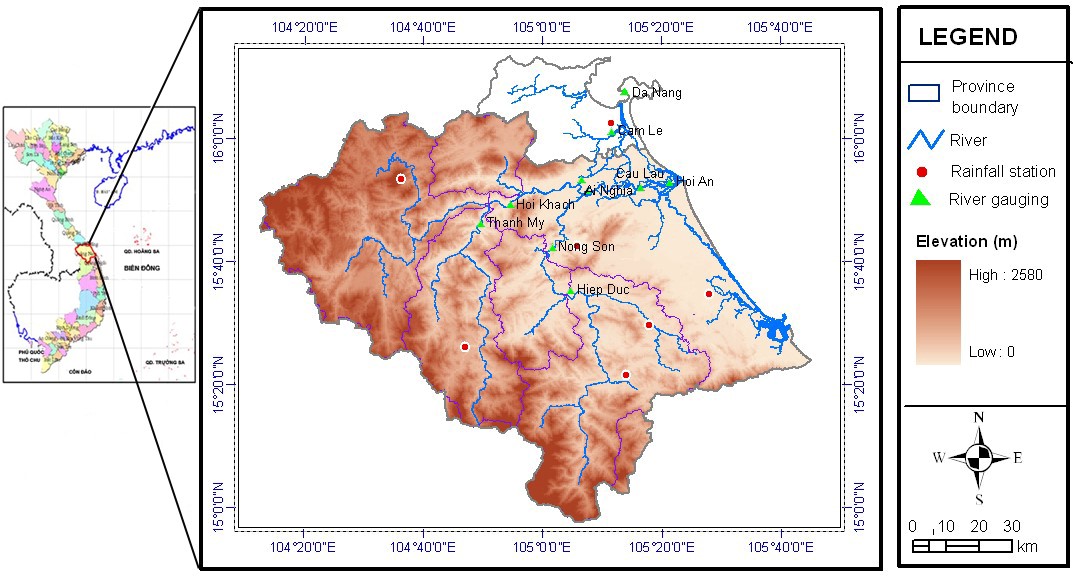08. EFFECTS OF MANGROVE DENSITIES AND WIDTH ON WAVE TRANSMISSIONS BY OPEN-SOURCE MODELS
Giới thiệu
The Mekong deltaic coasts have suffered from erosion and mangrove losses due to many relative threats in human activities, bringing to coastal instabilities. The massive and large number of constructions, such as sea dikes, revetments, and sea walls, tend to break the equilibrium in multiple locations along the coasts. As a result, a significant reduction of mangroves comes along in qualitative and quantitative variations, for example, the number of trees in one location and the healthy width of mangroves. An observation from Google Imagine Engine in multiple sites along the Mekong Deltal coasts shows an average width retreated from 2006 to 2016 was about 60 m. In this study, open-source models, SWAN and SWASH - Developed by Delft University of Technology, are implemented to assess the effect of density and width on wave transmission in Nhat Mat ward, Bac Lieu province, Vietnam. The present results show a significant influence of density on wave transmission, while the larger width of mangroves creates more damping space for waves. Moreover, wave reduction rates (Kt = Ht/Hi, where Hi and Ht are the incoming and transmission wave heights) are related to densities by the power fit. From these results, it is hypothesized that wave height reduction can be predicted via the density of mangroves.
Toàn văn bài báo
Trích dẫn
[2]. E. L. Gilman, J. Ellison, N. C. Duke, and C. Field (2008). Threats to mangroves from climate change and adaptation options: a review, Aquat Bot, vol. 89, no. 2, pp. 237–250.
[3]. N. C. Duke and K. Schmitt (2015). Mangroves: unusual forests at the seas edge, Tropical forestry handbook. Pancel L., Kohl M.(ed), Springer, p. 24.
[4]. P. N. Hong and H. T. San (1993). Mangroves of Vietnam, vol. 7. Iucn.
[5]. A. E. Lugo and S. C. Snedaker (1974). The ecology of mangroves, Annu Rev Ecol Syst, vol. 5, no. 1, pp. 39–64.
[6]. M. A. Othman (1994). Value of mangroves in coastal protection, Hydrobiologia, vol. 285, no. 1–3, pp. 277–282.
[7]. Y. Mazda, M. Magi, M. Kogo, and P. N. Hong (1997). Mangroves as a coastal protection from waves in the Tong King delta, Vietnam, Mangroves and salt marshes, vol. 1, no. 2, pp. 127–135.
[8]. K. Furukawa and E. Wolanski (1996). Sedimentation in mangrove forests, Mangroves and salt marshes, vol. 1, no. 1, pp. 3–10.
[9]. C. Woodroffe (1992). Mangrove sediments and geomorphology, Tropical mangrove ecosystems, pp. 7–41.
[10]. D. Alongi (2009). The energetics of mangrove forests. Springer Science & Business Media.
[11]. K. Kathiresan (2003). How do mangrove forests induce sedimentation?, Rev Biol Trop, vol. 51, no. 2, pp. 355–360.
[12]. L. K. Phan, J. S. M. van Thiel de Vries, and M. J. F. Stive (2014). Coastal Mangrove Squeeze in the Mekong Delta, J Coast Res, pp. 233–243, doi: 10.2112/JCOASTRES-D-14-00049.1.
[13]. S. A. Kalloe, B. Hofland, J. A. A. Antolínez, and B. K. van Wesenbeeck (2022). Quantifying Frontal-Surface Area of Woody Vegetation: A Crucial Parameter for Wave Attenuation, Front Mar Sci, vol. 9, p. 820846.
[14]. V. D. Vĩnh, T. A. Tú, T. Đ. Thạnh, and V. Đ. Thái (2010). Vai trò làm giảm tác động của dòng chảy, sóng do rừng ngập mặn ở khu vực ven bờ Bàng La - Đại Hợp (Hải Phòng), Hội nghị khoa học và Công nghệ biển toàn quốc lần thứ V.
[15]. T. Dao, M. J. F. Stive, B. Hofland, and T. Mai (2018). Wave Damping due to Wooden Fences along Mangrove Coasts, J Coast Res, vol. 34, no. 6, pp. 1317–1327, doi: 10.2112/JCOASTRES-D-18-00015.1.
[16]. H. T. Dao, B. Hofland, T. Suzuki, M. J. F. Stive, T. Mai, and L. X. Tuan (2021). Numerical and small-scale physical modelling of wave transmission by wooden fences.
[17]. T. Đ. Hoàng, L. V. Văn, L. N. Thị, and H. V. Thu (2022). 09. PHỤC HỒI RỪNG NGẬP MẶN BẰNG TƯỜNG MỀM DỌC BỜ BIỂN ĐỒNG BẰNG SÔNG CỬU LONG: CƠ CHẾ VẬT LÝ VÀ THẨM ĐỊNH MÔ HÌNH SWASH, Science Journal of Natural Resources and Environment, no. 40, pp. 84–96.
[18]. C. C. Mei (1989). The applied dynamics of ocean surface waves, vol. 1. World scientific.
[19]. G. B. Whitham (2011). Linear and non-linear waves. John Wiley & Sons.
[20]. M. Zijlema ( 2012). Modelling wave transformation across a fringing reef using SWASH.
[21]. M. Zijlema, G. Stelling, and P. Smit (2011). SWASH: An operational public domain code for simulating wave fields and rapidly varied flows in coastal waters, Coastal Engineering, vol. 58, no. 10, pp. 992–1012.
[22]. M. Zijlema and G. S. Stelling (2005). Further experiences with computing non‐hydrostatic free‐surface flows involving water waves, Int J Numer Methods Fluids, vol. 48, no. 2, pp. 169–197.
[23]. P. Smit, M. Zijlema, and G. Stelling (2013). Depth-induced wave breaking in a non-hydrostatic, near-shore wave model, Coastal Engineering, vol. 76, pp. 1–16.
[24]. D. P. Rijnsdorp, P. B. Smit, and M. Zijlema (2012). Non-hydrostatic modelling of infragravity waves using SWASH, Coastal Engineering Proceedings, vol. 1, no. 33, p. 27.
[25]. T. Suzuki, Z. Hu, K. Kumada, L. K. Phan, and M. Zijlema (2019). Non-hydrostatic modeling of drag, inertia and porous effects in wave propagation over dense vegetation fields, Coastal Engineering.
[26]. F. J. Mendez and I. J. Losada (2004). An empirical model to estimate the propagation of random breaking and nonbreaking waves over vegetation fields, Coastal Engineering, vol. 51, no. 2, pp. 103–118.
[27]. C. Mai Van, A. Ngo, T. Mai, and H. T. Dao (2021). Bamboo Fences as a Nature-Based Measure for Coastal Wetland Protection in Vietnam, Front Mar Sci, vol. 8, p. 1430, [Online]. Available: https://www.frontiersin.org/article/10.3389/fmars.2021.756597
[28]. S. Tas (2016). Coastal protection in the Mekong Delta: wave load and overtopping of sea dikes as function of their location in the cross-section, for different foreshore geometries.
[29]. V. H. Hoang and H. N. Nguyen ( 2006). Result on study of wave field on Dong Nai, Sai Gon estuaries and suggestion of sea bank and river mouth protection methods, in Vietnam-Japan Estuary Workshop in collaboration between Tohoku University and Water Resources University, pp. 140–150.
[30]. K. L. Phan, M. J. F. Stive, M. Zijlema, H. S. Truong, and S. G. J. Aarninkhof (2019). The effects of wave non-linearity on wave attenuation by vegetation, Coastal Engineering, vol. 147, pp. 63–74.
[31]. T. Mai, T. Dao, A. Ngo, and C. Mai ( 2019). Porosity Effects on Wave Transmission Through a Bamboo Fence, in International Conference on Asian and Pacific Coasts, pp. 1413–1418.
[32]. H. T. Dao, B. Hofland, M. J. F. Stive, T. Mai, and A. Ngo ( 2022). Design Considerations for Brushwood Fences Concerning Bathymetry and Fence Locations, in Proceedings of the 2nd Vietnam Symposium on Advances in Offshore Engineering: Sustainable Energy and Marine Planning, pp. 238–245.





